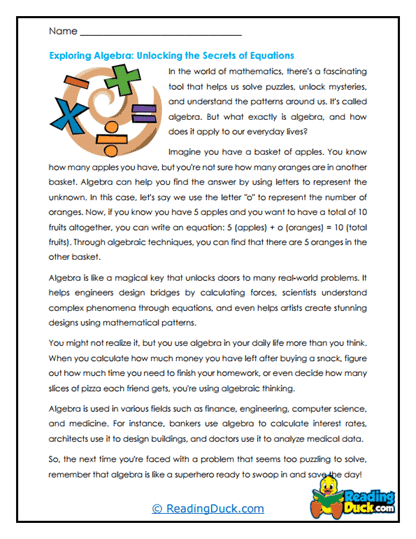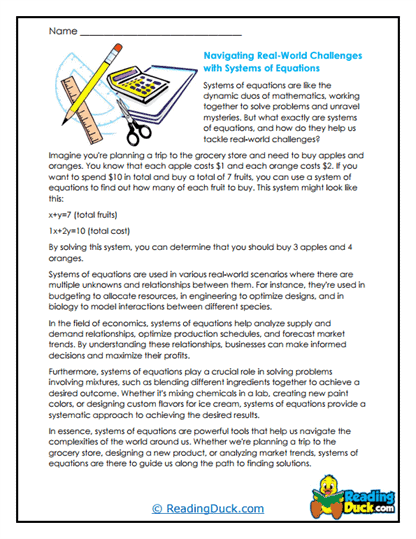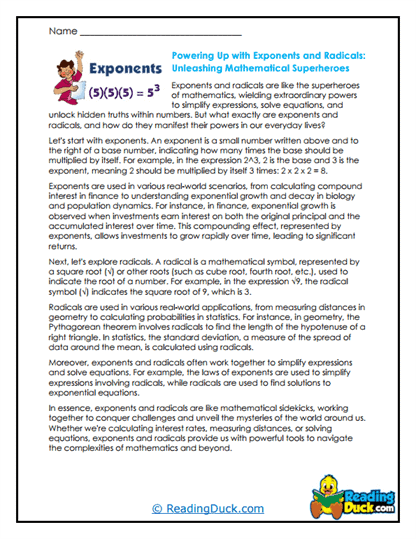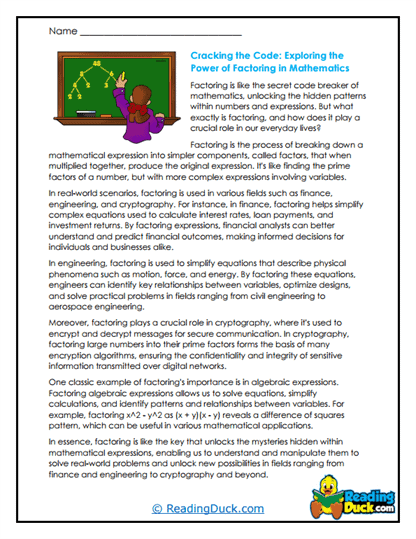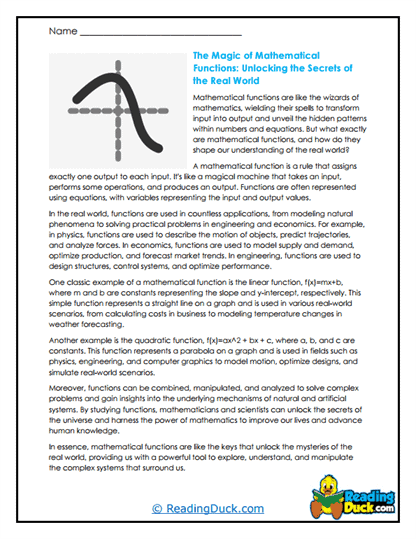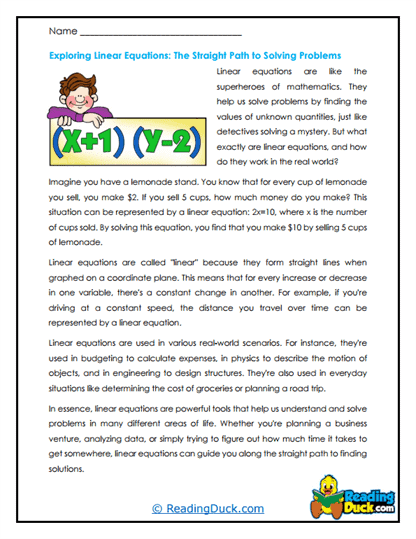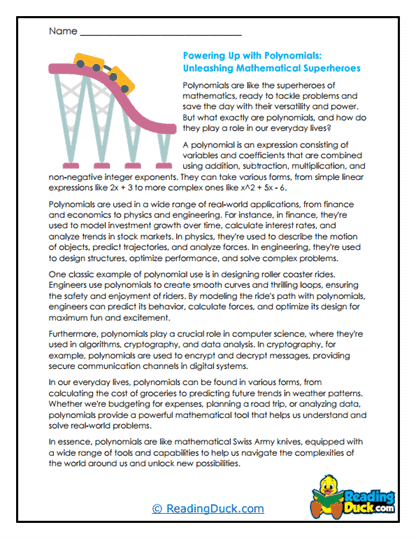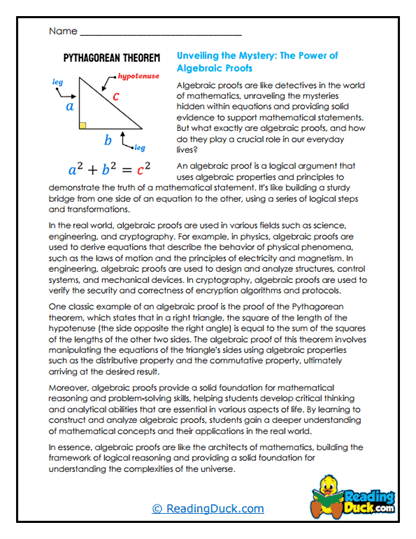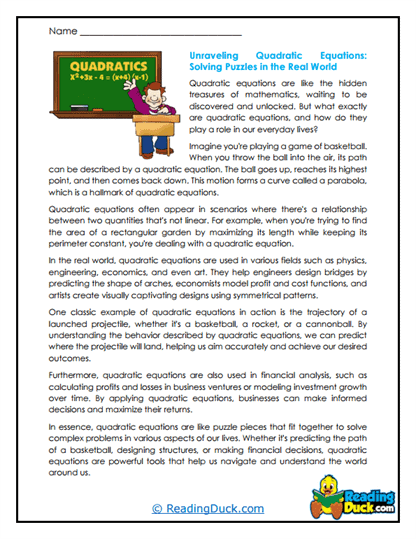Algebra Worksheets
About Our Algebra Worksheets
Our Algebra worksheets provide a comprehensive and engaging approach to understanding the fundamental concepts of algebra, designed to guide students through the various topics with clarity and practical application. These worksheets help students build a strong foundation in algebraic principles, making them an essential resource for any math curriculum.
Each worksheet set in our Algebra collection focuses on a specific aspect of the topic, ensuring that students can gradually build their knowledge and skills. Each set includes:
- Multiple Choice Questions: These questions assess students’ grasp of key algebraic concepts, allowing them to demonstrate their understanding through problem-solving and equation manipulation.
- Short Answer Questions: This format challenges students to apply their knowledge by solving algebraic problems and explaining their reasoning in their own words, reinforcing their comprehension of the material.
- Open-Ended Questions: These questions encourage students to think critically and creatively, inviting them to explore algebraic concepts in greater depth and reflect on their personal approach to solving problems.
These worksheets not only assess students' understanding but also enhance their connection to the material. Each worksheet set includes an answer key, making it easy for teachers and parents to review students’ work. All worksheets are available as PDF files, which can be easily viewed electronically, downloaded, and printed.
Understanding Algebra: Building Blocks of Mathematical Thinking
Algebra is often considered the language of mathematics because it provides the tools needed to describe patterns, solve equations, and understand the relationships between numbers. Introducing students to algebra is like giving them the keys to unlock more advanced areas of math and science. Let’s take a closer look at what algebra is and why it’s so important.
Key Aspects of Algebra:
- Variables and Expressions: Algebra introduces the concept of variables—symbols that represent numbers in equations and expressions. This allows students to generalize mathematical relationships and solve problems that involve unknown quantities. Understanding how to work with variables is foundational to all algebraic thinking.
- Equations and Inequalities: One of the central components of algebra is solving equations and inequalities. Students learn to manipulate these mathematical statements to find the value of the unknown variable. This process not only builds problem-solving skills but also helps students develop logical thinking.
- Functions and Graphs: Algebra is closely linked to the study of functions, which describe how one quantity changes in relation to another. Students learn to represent functions using equations and to visualize these relationships with graphs. Understanding functions is crucial for exploring more complex mathematical concepts in later studies.
- Polynomials and Factoring: As students advance in algebra, they encounter polynomials—expressions that involve multiple terms combined through addition, subtraction, and multiplication. Learning how to factor polynomials is a key skill that allows students to simplify expressions and solve more complex equations.
- Quadratic Equations: Quadratic equations, which involve variables raised to the second power, are an important topic in algebra. Students learn various methods for solving these equations, such as factoring, completing the square, and using the quadratic formula. Mastery of quadratic equations is essential for success in higher-level math courses.
- Algebraic Reasoning: Beyond the specific topics, algebra teaches students how to think abstractly and logically. Algebraic reasoning involves recognizing patterns, making generalizations, and solving problems systematically. These skills are not only valuable in math but also in many other areas of life and work.
By understanding these key aspects of algebra, students can build a strong mathematical foundation that will support their studies in other areas of math, science, and beyond. Algebra is not just a set of rules and procedures; it’s a way of thinking that helps us make sense of the world.
Examples of Real-World Applications
Algebra is not just an abstract concept confined to the classroom—it’s a powerful tool that we use in many aspects of everyday life. Here’s how algebra applies to real-world situations:
- Financial Planning: Algebra is used in budgeting and financial planning, helping individuals calculate interest, loan payments, and savings over time. Understanding algebraic equations is essential for managing personal finances effectively.
- Engineering and Construction: Engineers and architects use algebra to design buildings, bridges, and other structures. Algebraic equations help them determine the necessary materials, dimensions, and loads to ensure safety and stability.
- Technology and Coding: Algebra is fundamental in computer programming and technology development. Algorithms, which are at the heart of coding, often rely on algebraic principles to function correctly.
- Medicine and Pharmacology: In the medical field, algebra is used to calculate dosages, understand the rate of drug absorption, and analyze the results of medical tests. Accurate calculations are crucial for patient safety and treatment effectiveness.
- Science and Research: Scientists use algebra to model natural phenomena, analyze data, and make predictions. Whether studying the growth of populations or the spread of diseases, algebra helps researchers understand and quantify complex systems.
- Business and Economics: Algebra is used in business to analyze profit margins, calculate costs, and forecast future trends. Economists use algebraic models to study markets, consumer behavior, and economic growth.
- Environmental Studies: Algebra helps environmental scientists model climate change, track pollution levels, and develop strategies for sustainability. Understanding the mathematical relationships in environmental data is key to addressing global challenges.
These examples show that algebra is not just a subject to be studied in isolation—it’s a practical tool that empowers us to solve problems and make informed decisions in various fields.
Using These Worksheets in Class
To get the most out of our Algebra worksheets, teachers and parents can incorporate them into their lessons in a variety of effective and creative ways. Here are some tips for using these worksheets in the classroom or homeschool setting:
Make Connections to Real Life:
- Contextual Learning: Whenever possible, connect algebraic concepts to real-world situations that are relevant to students’ lives. For example, when teaching about linear equations, discuss how these equations can be used to calculate costs in everyday shopping or to understand trends in data. Making these connections can help students see the value of algebra in their own lives.
- Problem-Solving Challenges: Use the worksheets as part of problem-solving challenges where students can apply algebraic concepts to scenarios they might encounter outside the classroom. This approach not only reinforces their learning but also makes the material more engaging and practical.
Encourage Collaborative Learning:
- Group Work: Assign worksheets as group activities where students can work together to solve problems and discuss their thought processes. Collaborative learning encourages students to share ideas, clarify their understanding, and learn from one another.
- Peer Teaching: Encourage students who grasp certain algebraic concepts quickly to help their peers who might be struggling. Peer teaching can be a powerful way for students to reinforce their own understanding while helping others.
Incorporate Technology:
- Digital Tools: If students have access to computers or tablets, use digital tools and apps that complement the worksheets. Online graphing calculators, algebra software, and educational games can provide interactive ways for students to practice algebraic concepts.
- Virtual Classrooms: In a homeschool or remote learning setting, use virtual classrooms or online platforms to assign and review the worksheets. This allows for immediate feedback and interactive discussion, making the learning experience more dynamic.
Create a Positive Learning Environment:
- Celebrate Progress: Regularly acknowledge and celebrate students’ progress as they work through the algebra worksheets. Whether through verbal praise, stickers, or a progress chart, recognizing their efforts can boost motivation and confidence.
- Encourage Perseverance: Algebra can be challenging for many students, so it’s important to encourage perseverance and a growth mindset. Remind students that making mistakes is a natural part of the learning process and that their understanding will deepen with practice.
Adapt to Individual Learning Needs:
- Differentiated Instruction: Use the variety of worksheets to differentiate instruction based on students’ individual needs. For students who need more practice, offer additional worksheets on fundamental concepts. For advanced students, provide more challenging problems that require higher-order thinking.
- Personalized Feedback: When reviewing completed worksheets, provide personalized feedback that guides students in improving their understanding. Highlight what they did well and offer constructive suggestions for areas where they can improve.
By using these strategies, teachers and parents can help students develop a strong understanding of algebra and build the confidence they need to succeed in math. The Algebra worksheets are a valuable resource that can be used in flexible and creative ways to support learning, making algebra an accessible and engaging subject for all students. Through consistent practice and real-world applications, students will not only master algebraic concepts but also appreciate their relevance and importance in everyday life.
